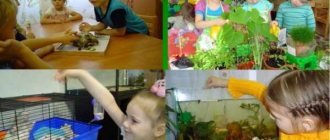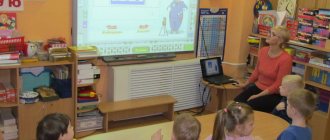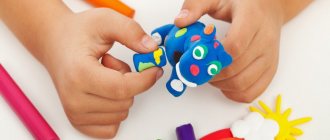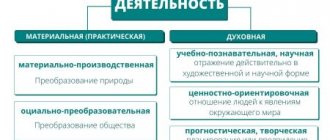Project of the “Checkers Debut” program for playing checkers for senior preschool children aged 5-7 years
Club leader: teacher
Content
Explanatory note………………………………………………………3
1. Goals and objectives of the program……………………………………………………5
2. Stages of program implementation…………………………………………….8
2.1. first stage - preparatory …………………………………………8
2.2. second stage - practical implementation of the program……………………..9
2.3. third stage – generalizing……………………………………………14
3. Monitoring………………………………………………………………………………15
4. Methodological and information support of the program……………17
11. Appendix………………………………………………………….18
I. Explanatory note
1.1. Justification of the need to develop and implement the proposed program in the educational process of kindergarten.
The game of checkers is very popular in our country. In terms of popularity, checkers ranks eighth among other sports. This wise folk game has firmly entered our everyday life. Its age is very respectable - at least 5 thousand years. As an intellectual sport, checkers has become a recognized part of human culture.
Peaceful checkers wrestling is a competition in endurance, logical thinking, and the ability to foresee the development of events. The rules of the game of checkers are simple and generally accessible. Therefore, some people have a misconception about this game as being very easy and simple. In reality, learning to play checkers well is far from easy and simple, since this game contains many difficulties, subtleties and depth.
There is no need to prove the obvious usefulness of the game of checkers. It will help instill in children discipline, perseverance, the ability to concentrate and think logically. And it is absolutely necessary to preserve and develop the system of teaching checkers in preschool institutions. Increasingly, kindergarten teachers are asking questions: “Is it possible to teach preschool children to play checkers or is this only available to gifted children? Are kids up to the task of this useful, exciting game? A detailed answer was given in his article “On the question of training, education and development of six-year-old children” by Doctor of Psychology, Professor (although it did not directly talk about checkers):
“Currently, the attention of scientists around the world is focused on the enormous potential development opportunities hidden in preschool childhood... Pedagogical, psychological and physiological research conducted at the Institute of Preschool Education of the Academy of Sciences of the USSR... as well as abroad, indicate that the potential psychophysiological opportunities for acquiring knowledge and general development in children 5–6 years old, but also at an earlier age, then it has long received a positive solution in Soviet pedagogy” (Soviet pedagogy. - 1973. - No. 1).
Such a strong, authoritative conclusion about the functional characteristics of the body of five to six-year-old children gives every reason to widely popularize checkers among older preschoolers.
For systematic and consistent work with children on the basics of checkers art, a training program is simply necessary. There are checkers programs for sports schools. These programs are designed to train high-class athletes.
This program is intended for the checkers club of preschool educational institutions and provides for children to study material on theory and practice, the history of checkers, and participate in competitions. Along with this, the circle is working on the proper organization of leisure time for preschool children, instilling activity in them, and developing norms and principles of moral behavior.
A distinctive feature of this program is the great emphasis on the initial training of children, mainly of senior preschool age, starting from scratch.
The checkers lesson program provides for the acquisition of the basic knowledge of the theory and practice of playing checkers in a multiple, descriptive and fabulous form. In terms of creativity, systematic classes in this program should bring the beginning checkers player closer to the ability to reason mentally, analyze, build witty combinations on the checkers board, and anticipate the plans of a partner. With further improvement of playing technique, you need to learn to search and patiently find the most appropriate move in each position.
For the successful operation of the circle, a sufficient supply of equipment is required: checkers with boards, a chess clock, a demonstration board, an office for classes, checkers literature for the teacher.
II. Purpose and objectives of the program project
Target:
Disclosure of the mental, moral, aesthetic, volitional potential of the personality of pupils.
Tasks:
Educational:
- teaching the basics of checkers; teaching simple combinations, theory and practice of checkers.
Educational:
- fostering an attitude towards checkers as a serious, useful and necessary activity with a sporting and creative orientation; nurturing perseverance, dedication, resourcefulness, attentiveness, confidence, will, hard work, collectivism; developing in children the ability to apply acquired knowledge in practice.
Educational:
- developing children's desire for independence; development of children's mental abilities: logical thinking, the ability to make calculations several moves ahead, imaginative and analytical thinking.
Aesthetic:
- While playing, a child lives in a world of fairy tales and transformations of an ordinary board and checkers into magic ones, and the ability to find the extraordinary in the ordinary enriches the child’s imagination, brings aesthetic pleasure, and makes one admire the amazing game.
Physical:
- implementation of comprehensive physical development of pupils.
Educational game project “Checkers Opening”
An experimental educational program designed for children aged 5–7 years. The implementation period is 2 years. The number of children in the group is 6 people (on average). Classes in the first year of study are recommended to be held twice a week < Figure 1
>.
Learning the game of checkers is a complex and time-consuming process. Therefore, it is very important to bring to the consciousness of the preschooler that achieving sports success is possible only with perseverance and hard work. Without cultivating a strong will, you cannot achieve serious results in checkers. The trainer-teacher must constantly emphasize this idea both during classes in the circle and outside the circle. Every preschooler is required to know the checkers code.
While studying according to the program, children acquire a number of qualities: perseverance, concentration, consistency of reasoning, ingenuity, the ability to analyze, think abstractly and logically, and use associative fantasy, which will help them solve many life situations.
Organization of checkers classes
The game of checkers is diverse and not as simple as it seems at first glance. Checkers have their own characteristics, and the difficulty in leading a battle is that all checkers and warriors are twins. Checkers classes are planned to be conducted according to the principle of moving from a simple explanation to a more complex one. Educational material is presented in the form of fairy tales < Figure 2
>. Classes are conducted in a combined way, alternating elements of theoretical and practical novelty with gaming and competitive skills, as well as educational activities. In the process of practicing checkers, children receive a whole range of useful skills and abilities necessary in practical activities and life. When conducting classes, you should focus on the most active children, but you must strive to ensure that the majority of students also learn this material. At the end of the school year, it is recommended to hold final classes at which the achievements of each child are reviewed and diplomas are awarded.
Condition
Our project is the organization of interconnected scientific, moral, aesthetic, physical, intellectual and practical activities of teachers, parents and children of senior preschool age.
The project is based on the principles of accessibility, scientificity, and visibility.
In organizing a subject-development environment
According to the project, the following were prepared: a checkers museum, a checkers room, an information stand “Checkers Debut”, checkers corners in group rooms, equipment and demonstration material <
Figure 3
>
Participants:
Head, senior teacher, educators, children, parents, preschool specialists.
Information support for the project:
1. Newspaper “Swallow News”;
2. Internet sites of the Education Department.
Social connections with other organizations:
1. City Department of Education;
2. Scientific and methodological cooperation with the Department of Preschool and Primary Pedagogy and Psychology of NVGU Nizhnevartovsk;
3. Generalization of work experience through the Nizhnevartovsk Regional Educational Institution;
4. Practice for students of the pedagogical institute;
5. Practical training for students of the pedagogical college;
6. Work on continuity with schools where kindergarten graduates enter: secondary school No. 9, secondary school No. 31.
7. Methodological and judicial assistance from the Chess and Checkers Center of Nizhnevartovsk.
Project stages:
Stage 1. Preparatory stage (September-November 2011)
1. Master class by trainers of the Chess and Checkers Center for teachers of preschool educational institutions (responsible teacher);
2. Consultation with the teacher “Checkers play space for children of senior preschool age” (for parents and educators);
3. Preparing the classroom for working with children in a checkers club (responsible teacher);
4. Equipping the checkers circle with demonstration and handout materials (responsible senior teacher);
5. Ordering and setting up a stand for the checkers club (responsible teacher);
6. Design of a checkers corner for children in group rooms of senior preschool age (responsible teachers);
7. Design of the checkers museum (responsible teacher);
8. Planning and drawing up scenarios for entertainment, sports competitions by age (responsible educator, specialists);
9. Together with children and parents, making checkers games for the museum-exhibition - (responsible educators).
Stage 2. Project implementation (September 2011 to November 2013)
Thematic planning. 1 year of study 2011–2012 (for children of senior preschool age 5-6 years)
| № | Club activities | Deadlines | Responsible |
| October | Head of the circle | ||
| 1 | Class. Excursion to the Checkers Museum. History of checkers. | ||
| 2 | Class. The fairy tale begins... (general concepts about checkers) | november | |
| 3 | Class. Checkers board and checkers. Checkered roads. | ||
| 4 | Practical consolidation of material | ||
| 5 | Class. Checker fields. | ||
| 6 | Practical consolidation of material | ||
| 7 | Class. Diagonal | ||
| 8 | Practical consolidation of material | ||
| 9 | Class. How checkers move | December | |
| 10 | Practical consolidation of material | ||
| 11 | Class. Basic rules of the game of checkers | ||
| 12 | Practical consolidation of material | ||
| 13 | Class. Goals of the game and determining the outcome of the game | ||
| 14 | Practical consolidation of material | ||
| 15 | Class. Different types of draw games | ||
| 16 | Practical consolidation of material | ||
| 17 | Class. How to start a game? | January | |
| 18 | Practical consolidation of material | ||
| 19 | Class. Introduction to the checkers tournament table. | February | |
| 20 | Practical consolidation of material | ||
| 21 | Class. Preparation for competitions | ||
| 22 | Practical consolidation of material | ||
| 23 | Practical consolidation of material | March | |
| 24 | Practical consolidation of material | April | |
| 25 | A checkers competition in a preschool educational institution between players. | May | |
| 26 | Competitions between players, checkers meetings, leisure activities, checkers tournaments | June July |
Thematic planning. 2nd year of study, 2012–2013. (for children of senior preschool age 6-7 years)
| № | Club activities | deadlines | responsible |
| 1 | Class. We make the best moves. | October | Head of the circle |
| 2 | Practical consolidation of material | ||
| 3 | Class. Simple combinations. | november | |
| 4 | Practical consolidation of material | ||
| 5 | Class. Fundamentals of positional play. | ||
| 6 | Practical consolidation of material | ||
| 7 | Class. Combination techniques | ||
| 8 | Practical consolidation of material | ||
| 9 | Class. Binding | December | |
| 10 | Practical consolidation of material | ||
| 11 | Class. Using extra tempo. | ||
| 12 | Practical consolidation of material | ||
| 13 | Class. Exchange. | ||
| 14 | Practical consolidation of material | ||
| 15 | Class. "Barrier". | ||
| 16 | Practical consolidation of material | ||
| 17 | Class. Achieving favorable opposition. | January | |
| 18 | Practical consolidation of material | ||
| 19 | Class. Petrov's triangle. | February | |
| 20 | Practical consolidation of material | ||
| 21 | Class. Preparation for competitions | ||
| 22 | Practical consolidation of material | ||
| 23 | Class. Stretching and pulling. | March | |
| 24 | Practical consolidation of material | April | |
| 25 | Efficiency and beauty of combinations. | May | |
| 26 | Competitions between players, checkers meetings, leisure activities, checkers tournaments | June July |
Organizational and pedagogical work with children in preschool educational institutions:
1. Conducting qualifying rounds (December-February).
2. Entertainment “Checkers Ball” (January 2014).
3. Participation of older children in the intra-garden winter sports competition in checkers (January-February 2014).
4. Together with parents, children’s productive activities on the topic: “Checkers fun” (March-April 2014).
5. Organization of role-playing, didactic, board-printed, verbal, outdoor games using checkers terminology.
Participation of children in district, republican Russian and international competitions and events:
1. Checkers competition. Among preschoolers (January)
2. City checkers competition (March)
3. Festival of intellectual games (sonora, chess, checkers, intellectual biathlon) (June)
Stage 3. Generalization stage. November 2013
1. Exhibition of children's works on the topic “The World of Checkers through the Eyes of Children”
2. Photo reports from events.
3. Preparation of methodological recommendations describing technologies for developing activities aimed at developing the intellectual and cognitive thinking of preschoolers.
4. Development of methodological recommendations for preparing preschool teachers to work with the “Checkers Debut” educational program, aimed at developing creative thinking.
5. Creation of a professional development environment in MDOU No. 16.
6. Creation of conditions for conducting, on the basis of MDOU No. 16, a system of developmental seminars to prepare teachers of other educational institutions to work with the program.
7. Conference on the results of the project.
8. Defense of the training program project at the expert council.
Monitoring the level of skills of preschoolers to play checkers.
Diagnostics of the development of children's ability to play checkers
(, Atayan children playing checkers. - Directory of a senior teacher. No. 8\August 2011)
Diagnostic technique:
Diagnosis of the development of children's ability to play checkers involves questions to the child, observation of his play with a teacher, peers, as well as conversations with parents about how the preschooler plays checkers at home.
Diagnostic map of skill development
senior preschoolers play checkers.
| Surname, baby name | Places checkers on the field | Beginning of the game | Checkers move | Fight of opponent's checkers | Solving Diagrams | King | Brings the game to an end |
| Move | The battle |
Explanations for the table items:
1. The child is asked to arrange checkers in the amount of 24 pieces of two colors for further play.
2. The teacher asks the child who starts the game and why? How to determine who is playing with white checkers?
3. The teacher invites the child to start the game, watching how he makes moves.
4. In the game, the teacher creates a situation in which the child has the opportunity to hit the opponent’s checkers either one at a time or several.
5. The teacher suggests playing out the diagrams in accordance with a certain condition.
6. The player’s understanding of the advantage of a king over a regular checker is checked directly during the game.
7. It is advisable to carry out the test in a game with both adults and peers.
8. If a child leaves a batch unfinished, the teacher should try to find out the reason. Reluctance to lose a game, resentment towards an opponent, a lag in the count of the opponent's beaten checkers is regarded as a low level of development of gaming motivation.
Criteria for evaluating results:
High level
– the child completed the task independently and correctly;
Average level
– to correctly complete the task, the child needs several independent attempts or a hint from the teacher;
Low level
– the child did not complete the task even after the teacher’s prompting.
Annex 1
Announcement to parents
Dear parents!
The “Checkers Debut” club is starting in our group.
Purpose of the circle:
1. Disclosure of the intellectual and volitional potential of the pupils’ personality.
2. Organization of leisure time and development of creative potential through the game of checkers.
3. Help the child feel the atmosphere of risk, teach him to see the mistakes made. Predict the results of your actions and feel safe, performing on equal terms with adult opponents and peers.
4. Help the child realize that in real life there are certain rules that we must follow, whether we like it or not. Any action we take can have certain consequences.
Program objectives:
Educational:
— teach the technique of playing checkers;
— introduce children to the theory of checkers.
Educational:
— activate the mental activity of preschoolers: train logical and strategic thinking, memory and observation;
— develop mental abilities: the ability to make calculations several moves ahead, imaginative and analytical thinking; learn to navigate on a plane.
Educational:
— to cultivate an attitude towards checkers as a serious and useful activity with a sporting and creative orientation;
— cultivate perseverance, determination, confidence and the will to win;
— to develop in students the ability to apply acquired knowledge in practice.
We kindly ask you to purchase the game “Checkers” for training with children at home.
Club leader:___________
Used Books
1.
I.
_ Started in a game of checkers. – M.: Physical culture and sport, 1965. – 72 p.
2.
, P
. Adventures on the checkers board. – L.: Leninzdat, 1969. – 128 p.
3.
G.
_ Let's learn to play checkers. – Kyiv: Healthy, 1985. – 88 p.
4.
A.
_ Checkers workshop. – Minsk: Harvest, 2004. – 288 p.
5.
Napreenkov
A. Checkers is interesting. – St. Petersburg: Litera, 1992. – 250 p.
6.
B.
_ Book about checkers. – M.: Physical culture and sport, 1990. – 320 p.
7.
I.
_ History of the development of Russian checkers. – M.: Physical culture and sport, 1982.
8.
,
N. Checkers opening course. – Minsk: Polymya, 1985. – 256 p.
9.
K.
_ Checkers. Collection of combinations. – Rostov n/d: Phoenix, 2007. – 160 p.
10.
M.
_ The checkers course has begun. – M.: Physical culture and sport, 1953. – 348 p.
11.
M.
_ How to learn to play checkers. – M.: Physical culture and sport, 1951. – 187 p.
12. M
. First lessons in the game of checkers. – M.: Physical culture and tourism, 1937.
13. Checkers for children/ , . Ed. 2nd, revised And additional – Rostov n/d: Phoenix, 2010. – 137 p.
Get text
Rules of the game "Chapaev"
- Each side must place checkers in horizontal rows, 8 pieces in each row.
- The opponent must click his finger on the chips to knock out everything from the opponent.
- The end of the game will be considered when all the opponent's pieces are knocked out.
- The opponent begins his move after one participant loses his piece or fails to knock out someone else’s.
- The player who was the first to knock out all the chips from the opponent moves one row higher in the second round.
In addition to its developmental value, playing checkers instills in children qualities that are important for their future life, such as the ability to think independently and bear responsibility for decisions made, and to deal adequately with failures and defeats. Since most children in preschool age are by nature very mobile and active and find it difficult to concentrate their attention for a long time, playing checkers develops in them such a quality as perseverance.
I hope the article was useful to you and you can easily teach your child to play checkers. I advise you not to forget about playing chess. Good luck!
Atlanbaj (Turkish checkers)
Eastern Europe
Number of players: 2
What you need to play: a board 8 by 8 squares and 16 checkers for each player
- Players take turns moving checkers forward or sideways. You cannot walk backwards or diagonally.
- When a checker lands on the opposite edge of the board, it becomes a king.
- To outwardly highlight the king, a checker of the same color is placed on it. The king can move forward, backward or sideways any number of squares.
- To eat an enemy piece, you need to jump over the checker to the free field behind it. You can eat several pieces in one move. Regular pieces do not have to eat the opponent's pieces, but the king must eat as many pieces as it can.
- The winner is the one who removed all the opponent's checkers from the board.
Checkers game: rules
- The checkers board for the Russian version of the game consists of 64 squares, painted black and white; the checkers are also black and white. Before the start of the fight, all figures are placed in the bottom three rows against a dark background.
- All moves in the game are carried out only on a dark background.
- The advantage of the first move always belongs to the white pieces.
- The figure moves forward diagonally to any free cell.
- If the player touches a piece, then he must move to it.
- The moves between the opponents alternate.
- If there is an enemy piece in front of the checker, and the field is free after it, then it can be eaten by making a move both forward and backward.
- Walking in the other direction with this position of the pieces is prohibited, even if you expose yourself to a blow
- In one move, if the enemy pieces are positioned well, you can eat several checkers at once.
- If the player managed to reach the opposite end of the board, then he turns over his piece, it turns into a king.
- The queen can move diagonally forward any number of squares. The queen also has access to backward moves.
- Any figure can eat the queen, given the appropriate position.
- The first player to eat all of the opponent's checkers wins.
How to teach a child to play checkers?
- The first lesson should begin with familiarization with the playing field. Let the child first try to arrange the figures correctly on his own; if it doesn’t work, come to the rescue.
- No need to hurry. Play only when the child wants it.
- Don't let your baby become overtired. No matter how interesting your game is, it is necessary to take breaks for physical education.
- Praise, encourage your child, create a situation of success for him, point out the most successful combinations, inspire victories and new achievements.
- Don’t scold if your child doesn’t understand something or makes the wrong move, be more patient.
- Don't give in! If the child wins all the time due to the fact that you have successfully “arranged” everything, then there will be no sense in such a game.
Along with the classic game of checkers, you can teach your child to play “Chapaev” and “Ugolki”. These types of checkers are no less interesting and exciting.







